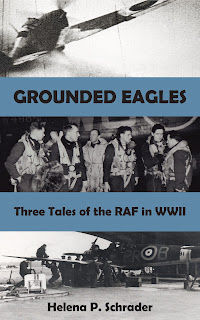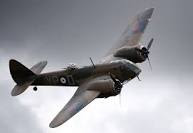MALTA ON THE OFFENSIVE
While the RAF's at times quixotic, almost always desperate, yet ultimately successful efforts to defend Malta have captured the imagination and attention of the media, novelists and film-makers, the RAF's contributions to Allied offensive operations in the Mediterranean theatre are often overlooked yet were arguably far more important -- possibly game changing.
Operating from the "unsinkable aircraft carrier" of Malta, the RAF undertook a wide range of roles, requiring a surprising array of different aircraft and crews trained for different missions. The number, type and mix of aircraft deployed on Malta was constantly changing and varied not only from month to month but day to day, depending on the overall strategic situation, aircraft and crew availability. To summarize, however, Malta was responsible for reconnaissance, sub-hunting, providing air cover to allied supply convoys, interdicting Axis
supply lines to North Africa, attacking Axis ports and air bases in both Italy and North Africa, and
last but not least conducting air-sea rescue operations for the crews of sunken ships and downed
aircraft. Over the course of the war, the types of aircraft based in Malta included bi-plane Gladiators and Swordfishes, Fulmars, Albacores, Hurricanes, Spitfires, Hudsons, Marylands, Baltimores, Sunderlands, Blenheims, Beauforts, Beaufighters, Mosquitoes, Wellingtons -- and probably more! What follows is only a short overview.
Even before the outbreak of the war with Italy, Malta's value as a base for reconnaissance aircraft was obvious and the RAF agreed to station Sunderland flying boats there on the assumption that the Italians might render airfields unusable, but the Sunderlands landed on indestructible water. In addition, the Fleet Air Arm (FAA) of the Royal Navy stationed a squadron of (biplane) Swordfish on the island. When the Italians finally attacked, the Sunderlands and Swordfish immediately demonstrated their offensive spirit and capabilities. Sunderlands not only kept an eye on Italian shipping, they attacked. A Sunderland from 202 Squadron sank the Italian ship Argonauta on 28 June and followed up with sinking the Italian submarine Rubino the following day. In the second incident, the Sunderland also landed and picked up the survivors of its victim. On 30 June, the Swordfish squadron bombed August harbor in Sicily.
With the Italian invasion of Greece in October 1940, Malta-based bombers became involved in supporting British operations in defense of Greece. Although the number, designations and aircraft of the units based on Malta were highly fluid and almost constantly changing, they included enough medium bomber and torpedo bombers to keep up a steady assault on Axis convoys in the Eastern Mediterranean. In addition, Malta's conventional bomber aircraft had already flown 217 sorties and delivered roughly 560 tons of bombs on the airfields in Sicily and the ports of Tripoli in North Africa and Naples in Italy.
In the same period, roughly 1,500 hours of reconnaissance had been flown, for the loss of three aircraft (one Sunderland, one Photo Reconnaissance Spitfire and one Maryland). The Sunderlands played a key role not only in locating but often shadowing Axis convoys long enough to call in attacks by Malta-based torpedo bombers. The Admiralty noted approvingly that this kind of cooperation between the RAF (Sunderland) locating and shadowing targets within range of the Swordfish was highly productive. The catch was the targets (i.e. enemy ships) had to be within range of the Swordfish -- and the Italians soon learned to give Malta a wide berth. A variation on this theme was to call in surface fighting ships, but again these had to be within range and given the speed of surface ships, the Sunderlands usually had to return for refueling before naval ships could arrive.
The Germans build-up continued and by February included Me109 escorts for their bombers. Within a short space of time the Me109s had effectively neutralized Malta's Hurricane fighter defenses thereby making a measurable impact on the offensive capabilities of the island. For example, in a raid on 26 February, six Wellingtons were destroyed on the ground and the only airfield suitable for Wellington operations (Luqa) was badly mauled. In addition, the Sunderlands were vulnerable to strafing attacks by fighters and in mid-March were pulled back to Alexandria -- 1,000 miles away -- severely impairing the Allies' ability to find, shadow and attack Axis convoys and naval assets.
March 1941 also saw the arrival of General Rommel and the German Afrika Korps in North Africa. The war in the Mediterranean was clearly "hotting up" and both Egyptian and Malta-based bombers were directed to concentrate their attacks on Tripoli and Benghazi. This they did, with Malta's bombers flying fifty-three sorties against Benghazi between 21 April and 4 May alone. In addition, Malta's Blenheims concentrated on "search and destroy" missions against shipping bound for North Africa and in 34 sorties made attacks on 15 ships, sinking 12 of them for the loss of just two aircraft. Some of their success can be attributed to the arrival of long-range Beaufighters which provided escort for the Blenheims far beyond the range of the Hurricanes. The Beaufighters also proved very useful for providing air cover for Allied convoys approaching or departing from Malta. In short, although Malta's offensive capabilities had been impaired, they had not been neutralized by the start of June 1941. At that point, the result still hung in the balance.
Then the British had a lucky break. In June 1941, the Luftwaffe withdrew in order to take part in the invasion of the Soviet Union. The task of subduing Malta reverted to the Italians and they proved incapable of dealing with the increased resources that had meanwhile reached the island. Not only were there now more fighters based on Malta, there were more anti-aircraft guns, and all installations had been hardened, expanded and improved. In consequence, Allied offensive action from Malta reached new levels of intensity, largely unimpeded by Italian counter-measures. The Sunderlands returned to Malta and flew roughly 1,000 reconnaissance sorties enabling surface ships to intercept Axis convoys and naval vessels. In August, the Wellingtons of Malta briefly (and unsuccessfully) turned their attentions to closing the Corinth Canal in an attempt to force Axis shipping into the Eastern Mediterranean. More successfully, the RAF attacked Tripoli and Benghazi. Indeed, successes were sufficient to encourage the Chief of Air Staff to approve sending yet more bombers to Malta in the form of two more Blenheim squadrons.
In September, Malta-based bombers damaged the Italian cruiser Bozano in Messina harbor. They sank three other ships as well, and continued to make raids on Naples, Tripoli and Benghazi. In total, Malta-based aircraft made 544 bombing sorties against targets in North Africa and departure ports in Italy, including hitting Tripoli 72 and Benghazi 102 times. In addition, Hurricanes were fitted with bomb racks and sent against targets in Sicily. Meanwhile, three Wellingtons equipped with airborne radar arrived in Malta to increase ship-hunting activities. The Blenheims, on the other hand, were becoming obsolete because low-level attacks on shipping were suicidal when merchantmen were escorted by naval vessels -- as was increasingly the case. The Blenheims were diverted to moonlight attacks against the land convoys traveling on the road between Tripoli and Benghazi instead.
The Axis powers had learned (like the Allies in the North Atlantic) that unescorted merchantmen were simply too vulnerable and almost every ship headed for North Africa in the second half of 1941 needed and received a heavy escort. This made the deployment of fighting ships a necessity and in October, the RN demonstrated its confidence in Malta's defenses by making Grand Harbor the home base for its Force K, composed of two cruisers and two destroyers. In a dramatic demonstration of what this meant, Force K responded to a Malta-based reconnaissance aircraft report of a convoy consisting of ten merchant ships with six escorting destroyers and promptly sank two destroyers and damaged a third, as well as sinking nine merchants ships and set the remaining tanker on fire -- all for no British losses.
Although the decision to conduct an intensified air campaign against Malta was taken in late 1941, it took the Luftwaffe time to assemble its forces. The offensive was launched in January 1942, and steadily gained momentum against an RAF fighter force still equipped exclusively with outdated Hurricanes. These lacked speed, ceiling, and firepower and were completely out-classed by the Me109s deployed against them. The Luftwaffe was supported by E-Boats which conducted attacks on shipping and laid minefields. The first Spitfires, which started to trickle in starting in March made little impact as Malta was experiencing severe air raids at such frequency that most of the Spitfires were rendered unserviceable before they became operational. British bombers and recce aircraft were likewise being destroyed on the ground -- along with the airfields and facilities for supporting them. Reluctantly, the RAF withdrew the Wellington bombers from Malta.
Not only that, but it was itself now vulnerable again. Fewer ships were getting through to Malta and even on arrival the round-the-clock bombing made it difficult to off-load cargoes. Reserves started to get low. Food rationing became very strict and applied to fighting units no less than to support units and civilians. Against this backdrop, the island as a whole was awarded the George Cross. It was a stunning, unique and well-deserved honor. But Malta was also nearing the breaking point and the Luftwaffe had come very close to achieving its objective of neutralizing Malta's offensive capability. (Below a photo of King George on the deck of the cruiser Aurora saluting Malta on his arrival June 20, 1943.)
The result was that the daily hounding of Malta eased off and in June it was no longer normal for multiple air raids to reach the island each day. Malta immediately went back on the offensive, stepping up reconnaissance and temporarily hosting torpedo bombers from Egypt for sorties against Axis shipping. At the end of the month a "detachment" of torpedo bombers returned on a "permanent" basis. (Below Bristol Beauforts)
Although the supply situation was still desperate, August saw the arrival of the oil tanker Ohio and the surviving ships of the now famous Operation Pedastal. By the end of August, Park's Spitfires were on the offensive along with the rest of Malta's aircraft -- strafing Sicily. September was viewed as "quiet," with "only" 60 alerts -- many of which proved to be false alarms, but offensive actions were reaching a new peak as the Allies made an all-out effort to stop Rommel, who was closing in on Cairo.
From November 1942 onward, Allied air superiority was sufficient to secure regular resupply of Malta and the acute supply shortages eased. Thereafter, Malta continued to engage in offensive operations with comparative impunity, including serving as the main planning base for the assault on Sicily in July 1943.
My novels about the RAF in WWII are intended as tributes to the men in the air and on the ground that made a victory against fascism in Europe possible.
Riding the icy, moonlit sky,
they took the war to Hitler.
Their chances of survival were less than fifty percent.
Their average age was 21.
This is the story of just one bomber pilot, his crew and the woman he loved.
It is intended as a tribute to them all.
Buy now on amazon or Barnes and Noble.
MORAL FIBRE is the WINNER OF A HEMINGWAY AWARD 2022 and was a FINALIST for the BOOK EXCELLENCE AWARD IN HISTORICAL FICTION.

"Where Eagles Never Flew" was the the winner of a Hemingway Award for 20th Century Wartime Fiction and a Maincrest Media Award for Military Fiction. Find out more at: https://crossseaspress.com/where-eagles-never-flew
For more information about all my aviation books visit: https://www.helenapschrader.com/aviation.html



















Sir Alec Guinness in "Malta Story." One of my favorites.
ReplyDeleteAnother fine lesson, Professor.